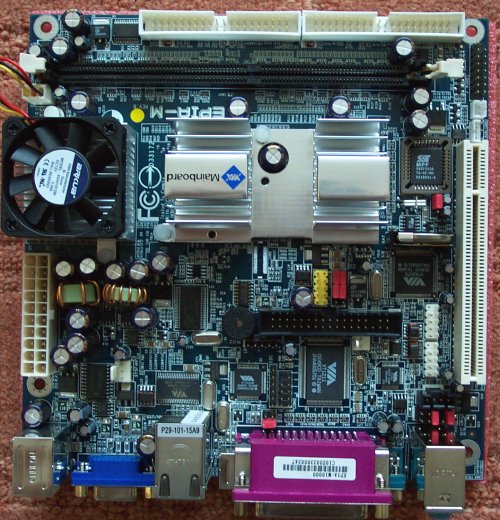Layout and Features

Just have a look at the DDR slot sitting at the top of the board. That should give you some indication of just how small the Mini-ITX form factor is. Measuring 17cm by 17cm, it's barely larger than a standard CD case. Feature integration with minimal size appears to be one of the key aims pursued by the EPIA range. 2 standard ATA133 ports sit at the very top of the board. A sensible location given the busy-looking nature of the board. Our friend, the Nemehiah, sits below a small heatsink and fan combination. The fan may only be a diddy 40mm affair, although by spinning at over 6,000RPM it does produce a whiney, high-pitched sound.

We've touched on just what a low wattage processor the Nehemiah is, so it's disappointing to not see a totally passive solution. That would have boosted its appeal immeasurably, we think. The twin bridges are hidden under a custom heatsink. This is probably a reasonably good idea given the lack of ventilation of a proposed EPIA case.

Features, features, and features is what the EPIA M10000 screams. VIA's own VT6307 2-port FireWire controller sits just below the vertically mounted CMOS battery. The headers required for IEEE1394a usage are located just below. The multi-bracket is an excellent inclusion. Not only does it hook up to four motherboard headers, it does this by only taking up one PCI slot.

Why use anyone else's PHYs when you can use your own, that seems to be VIA's sensible thinking. The very right features the VT1616 audio CODEC. It's similar to most premium on-board software CODECs in that it supports 6-channel sound and S/PDIF output, all at 18-bit resolution. VIA dub it Vinyl Six-Track for its supposedly smooth sound. Basic listening showed it to be more than capable of handling basic OS sounds. That's quite important because it'll be extensively used in conjunction with video or audio playback. The back panel has provision for 6-channel sound, too.
Another important facet for the EPIA M10000 is the need to output video streams to external sources. Here's where the VT1622M comes into play. This digital encoder takes the feed from the CLE266 NB and outputs it to an external source. Its in-built scaling ensures that it the video stream is correctly outputted with a resolution of up to 1024x768. We'll have a look at its attributes on the following page. Lastly, and on the right, is VIA's VT6103 10/100 PHY. It's simply there to route the SB's signal effectively.

The fruit of the respective features' labours is found on the back panel. Going from left to right we find PS/2 ports, HD15 VGA connection, dual USB 2.0/1.1 ports, 10/100 LAN, S-Video, Coaxial S/PDIF, parallel and serial ports and audio jacks capable of outputting 6-channel sound. The coax S/PDIF is a hybrid connector. A simple jumper relocation and it switches into a video-out coaxial connection.









